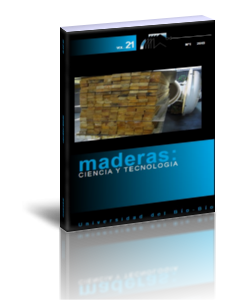Effectiveness of Copper chrome arsenate and used engine oil in protecting fencing posts of Ugandan grown eucalypt clone GC550 and Phoenix reclinata against termite attack
Keywords:
Incidence, severity, treated posts, wood preservation, wood protectionAbstract
Eucalypts and Phoenix reclinata posts are the most commonly used species for fencing posts in urban areas of Uganda. Although eucalypts are known to be susceptible to termites, fencing posts are still used untreated. In this study, the effectiveness of Copper Chrome Arsenate and used engine oil in protecting Ugandan grown Eucalyptus grandis × Eucalyptus camaldulensis clone and Phoenix reclinata fencing posts against termite attack were assessed. The objectives were to determine (i) the incidence and (ii) severity of termite attack on Eucalyptus grandis × Eucalyptus camaldulensis and Phoenix reclinata fencing posts treated with Copper Chrome Arsenate or used engine oil. Ninety 2ft long samples of Eucalyptus grandis × Eucalyptus camaldulensis and P. reclinata posts were treated with Copper Chrome Arsenate or used engine and others left to act as control then buried in 1ft deep pits in the ground at a spacing of 1m by 1 in Eastern Uganda. The samples were visually inspected monthly for termite damage for 9 months. More than 80% of untreated samples of both species had been attacked by termites within the first month. Copper Chrome Arsenate treated Eucalyptus grandis × Eucalyptus camaldulensis and Phoenix reclinata samples were first attacked in the 8th and 5th months respectively. While used engine oil treated Eucalyptus grandis × Eucalyptus camaldulensis and Phoenix reclinata samples were first attacked in the 7thand 5th months respectively. The modal severity for samples of both species treated with either Copper Chrome Arsenate or used engine oil was class 1 (less than 1% of the sample volume eaten) while for the untreated samples it was class 5 (above 60% volume eaten) for the 9 months of field exposure. It was concluded that untreated posts of Eucalyptus grandis × Eucalyptus camaldulensis and Phoenix reclinata were highly susceptible to termite attack and that the protection offered by used engine oil or Copper Chrome Arsenate managed to restrict damage by termites to only less than 1% of the sample volume , over the 9 months of exposure for most of the sample posts. It is recommended that the experiment be repeated for a much longer period in order to ascertain the exact service life of the posts under these circumstances. Penetration and retentions of the preservatives in the posts should also be studied in order to ascertain their effect on the efficacy.
Downloads
References
Fatima, R.; Morrell, J.J. 2015. Ability of plant-derived oils to inhibit dampwood termite (Zootermopsis augusticollis) activity. Maderas-Cienc Tecnol 17(3): 685-690.
Kadir, R. 2017. Toxic effects of three selected Malaysian timbers plant extracts against subterranean termites. Maderas-Cienc Tecnol 19(4): 417-432.
Mattos, B.D.; Gatto, D.A.; Missio, A.L.; Lourençon, T.V. 2012. Influência de Tratamentos preservativos na propagação da onda ultrassônicana madeira de eucalipto. Scientia Plena, São Cristóvão 8(4): 1-6.
Mattos, B.D; Gatto, D.A; Cademartori, P.H.G; Stangerlin, D.M.; Beltrame, R. 2013. Durabilidade a campo da madeira de três espécies de Eucalyptus tratadas por imersão simples. Revista Brasileira de Ciências Agrárias 8 (4): 648-655.
McKee, R.H.; Plutnick, R.T. 1989. Carcinogenic potential of gasoline and diesel engine oils. Fundamental and Applied Toxicology 13 (3): 545-553.
Nyeko, P.; Olubayo, M.F. 2005. Participatory assessment of farmers’ experiences of termite problems in agro forestry in Tororo district, Uganda. Agricultural research and extension network. Network paper No. 143. < www.odi.org.uk/publications >. (Consulted 24/05/2018).
Orikiriza, L.J.B.; Nyeko, P.; Sekamatte, B. 2012. Farmers’ knowledge, perceptions and control of pestiferous termites in Nakasongola district, Uganda. Uganda Journal of Agricultural Sciences 13(1): 71-83
Pereira, P.A.C.; Stangerlin, D.M.; Rodrigues de Andrade, V.; Rodrigues, D.A.; de Melo, R.R.; Corassa, J.N .; Calegari, L. 2015. Efficiency of used oil engine as preservative of Amazonian woods submitted to xylophagous termites. Ciência da Madeira 6(3): 176-182.
Petit, B.; Montagnini, F. 2004. Growth equations and rotation ages of ten native tree species in mixed and pure plantations in the humid neotropics. Forest Ecology and Management 199(2-3): 243-257.
Ssemaganda, I.E.; Mugabi, P.; Tumwebaze, S.B. 2011. Effectiveness of selected preservatives in rotecting Ugandan grown Eucalyptus grandis wood against termite attack. Maderas-Cienc Tecnol 13(2): 135-142.
Soderlund, S. 2013. Ants and termites in small-scale plantain farms in Uganda. A comparison between agroforestry and non-agroforestry farms. Bachelors thesis submitted to the Department of Ecology, Swedish University of Agricultural Sciences.
Segu, K. 2012. Phoenix reclinata jacq. In: Brink, M; Achigan-Dako, E.G. (Eds.), Plant Resources of Tropical Africa 16 Fibres. pp.359-362: PROTA Foundation: Wageningen, The Netherlands. ISBN 9789290814818 - 602
Ssembajjwe, G.; Banana,Y. A.; Bahati, J.; Namubiru, E.; Mukasa, C.; Waiswa, S.; Matovu, S. 2005. Mugomba Forest Reserve Site Report. Third Visit 2005. Forestry Resources and Institutions Center: Kampala Uganda.
Turinawe, H.; Mugabi, P.; Tweheyo, M. 2014. Density, calorific value and cleavage strength of selected hybrid eucalypts grown in Uganda. Maderas-Cienc Tecnol 16(1): 13-24.

































